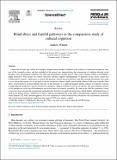Files in this item
Blind alleys and fruitful pathways in the comparative study of cultural cognition
Item metadata
| dc.contributor.author | Whiten, Andrew | |
| dc.date.accessioned | 2022-11-17T16:30:30Z | |
| dc.date.available | 2022-11-17T16:30:30Z | |
| dc.date.issued | 2022-12-01 | |
| dc.identifier | 281803813 | |
| dc.identifier | 79759da6-2d19-4dd6-9105-56f4b99710af | |
| dc.identifier | 85140482077 | |
| dc.identifier | 000880139900002 | |
| dc.identifier.citation | Whiten , A 2022 , ' Blind alleys and fruitful pathways in the comparative study of cultural cognition ' , Physics of Life Reviews , vol. 43 , pp. 211-238 . https://doi.org/10.1016/j.plrev.2022.10.003 | en |
| dc.identifier.issn | 1571-0645 | |
| dc.identifier.uri | https://hdl.handle.net/10023/26431 | |
| dc.description.abstract | A mere few decades ago, culture was thought a unique human attribute. Evidence to the contrary accumulated through the latter part of the twentieth century and has exploded in the present one, demonstrating the transmission of traditions through social learning across all principal vertebrate taxa and even invertebrates, notably insects. The scope of human culture is nevertheless highly distinctive. What makes our cultural capacities and their cognitive underpinnings so different? In this article I argue that in behavioural scientists' endeavours to answer this question, fruitful research pathways and their ensuing discoveries have come to exist alongside popular, yet in the light of current empirical evidence, highly questionable scenarios and even scientific blind alleys. I particularly re-evaluate theories that rely on the centrality of a supposed uniquely human capacity for imitative copying in explaining the distinctive capacity for massive cumulative cultural evolution (CCE) in our species. The most extreme versions of this perspective suffer logical incoherence and severe limits on scientific testability. By contrast the field has generated a range of rigorous observational and experimental methodologies that have revealed both long-term cultural fidelity and limited forms of CCE in non-human species. Attention now turns to directly investigating the scope, limits and underlying cognition of non-human versus human CCE, with a broader approach to factors additional to cultural transmission, notably the role of invention, innovation and evolved motivational biases underlying the scope of CCE in the species studied. | |
| dc.format.extent | 28 | |
| dc.format.extent | 3645143 | |
| dc.language.iso | eng | |
| dc.relation.ispartof | Physics of Life Reviews | en |
| dc.subject | Cumulative culture | en |
| dc.subject | Cultural evolution | en |
| dc.subject | Imitation | en |
| dc.subject | Ratchet effect | en |
| dc.subject | Zone of latent solutions | en |
| dc.subject | QH301 Biology | en |
| dc.subject | BF Psychology | en |
| dc.subject | MCC | en |
| dc.subject.lcc | QH301 | en |
| dc.subject.lcc | BF | en |
| dc.title | Blind alleys and fruitful pathways in the comparative study of cultural cognition | en |
| dc.type | Journal item | en |
| dc.contributor.institution | University of St Andrews. Institute of Behavioural and Neural Sciences | en |
| dc.contributor.institution | University of St Andrews. School of Psychology and Neuroscience | en |
| dc.identifier.doi | https://doi.org/10.1016/j.plrev.2022.10.003 | |
| dc.description.status | Peer reviewed | en |
This item appears in the following Collection(s)
Items in the St Andrews Research Repository are protected by copyright, with all rights reserved, unless otherwise indicated.

